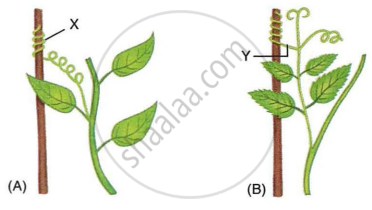Advertisements
Advertisements
Question
To which directional stimuli do roots respond?
Solution
The roots of a plant respond to gravity.
APPEARS IN
RELATED QUESTIONS
What happens to the dandelion flower
- during the daytime, and
- at night?
What is this phenomenon known as?
Name the plant organ which is positively phototropic.
Why is the closing of a dandelion flower at dusk (when it gets dark) not a tropism?
The movement of sunflower in accordance with the path of the sun is due to :
(a) photonasty
(b) phototropism
(c) hydrotropism
(d) chemotropism
The bending of the root of a plant away from a source of light is caused by a plant hormone called :
(a) cytokinin
(b) gibberellin
(c) abscisic acid
(d) auxin
A potted plant is growing in a transparent glass jar. In this plant, X and Y are the two growing parts having a lot of meristematic tissue. It is observed that the part X of this plant exhibits positive geotropism but negative phototropism. On the other hand, part Y of this plant exhibits negative geotropism but positive phototropism.
(a) Name the part X of plant.
(b) Name the part Y of plant.
(c) Which part of the plant, X or Y, will exhibit positive hydrotropism?
(d) Which part of the plant, X or Y, can have tendrils on it?
(e) Which phytohormone causes the part X to exhibit negative phototropism?
The top part A of the flask-shaped reproductive organ X in the flower of a plant secrets a surgery substance into its lower part B which goes towards the bottom part C of the flask-shaped organ. When a tiny grain D coming from the top part E of another reproductive organ Y i the flower falls on part A, it grows a long tube F through the organ X i response to the sugary substance and reaches the bottom part C of flask-shaped organ to carry out fertilisation.
(a) Name parts (i) organ X, and (ii) organ Y, inside the flower?
(b) Name parts (i) A (ii) B, and (iii) C, of flask-shaped organ.
(c) Name (i) grain D, and (ii) part E of organ Y.
(d) Name the tube F.
(e) What is the phenomenon of growing a long tube in response to sugary substance in the process of fertilisation in a flower known as?
What are tropic movements? Briefly explain various types of tropic movements in plants.
The leaves of the 'chhui-mui' plant begin to fold up and droop in response to a stimulus. Name the stimulus and write the cause for such a rapid movement. Is there any growth involved in the movement?
Study the diagrams given below and answer the following questions:

- Name the structures shown as X and Y in the figures (A) and (B), respectively.
- Write the functions performed by the structures X and Y.
- Name the phenomenon depicted and define it.
- How do the structures X and Y differ from each other?
- Give examples of the plants which show the said phenomenon.
